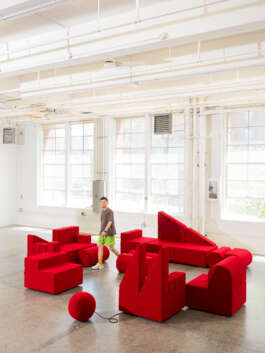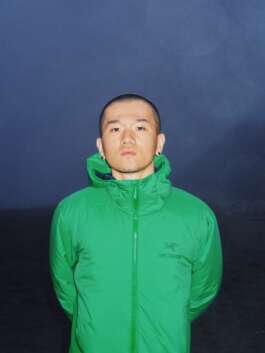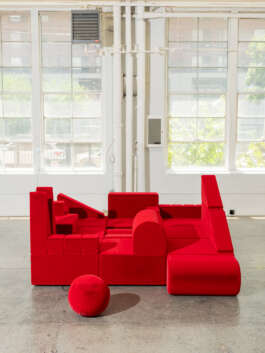



©Jed Abbi
COLLECTIBLE In-Depth
TANG THOUSAND / Shawn Tang
August 2025
This series, COLLECTIBLE In-Depth, unveils the backstage of contemporary creation. Tackling various topics from personal designer processes to the position of collectible design on the global design market, COLLECTIBLE In-Depth offers different views to suit all tastes. Today we speak with TANG THOUSAND / Shawn Tang.
COLLECTIBLE: Why do you focus on contemporary collectible design? What does it mean for you?
TANG THOUSAND / Shawn Tang: Contemporary collectible design offers us a space where function and emotion don’t need to be at odds. It allows for slowness and depth of which qualities often lost in mass production. For me, it’s a place where storytelling can materialize into form, where we can hold memory, ritual, or play in our hands. It blurs the line between sculpture and utility, object and experience.
C: What do you think collectible design brings compared to other more massively produced pieces?
ST: It offers presence. Not just as a physical artifact, but as a concentrated narrative. Mass-produced objects often aim for neutrality or universality; collectible design resists that. It holds specific gestures, moods, or imperfections. With both the Pilot collection and the Awning Lamps, each piece is as much a character as it is a furnishing. That kind of intimacy simply can’t be scaled.
C: How do you see the role of interdisciplinary collaboration shaping the future of collectible design?
ST: It’s essential. Our studio brings together architecture, photography, fashion, and fabrication. The Awning Lamps, for example, couldn’t exist without our dialogues with Chinatown metalworkers. Collaboration allows my object become a site where different languages and references intersect —which, I think, is what makes a meaningful design.
C: How do you question or challenge functionality in your design process?
ST: Function is never assumed. With Pilot, we asked: can seating provoke joy like a beach toy? Can utility feel ceremonial? With Awning Lamps: can signage migrate into the home without losing its original spirit? In both cases, we don’t reject function, we just expand it to include emotion, memory, and mood.
C: How do you navigate the tension between innovation and tradition in your approach to designing collectible objects?
ST: We try to see them as companions, not opposites. Pilot uses basic geometries—cubes, wedges— but arranges them in endlessly reconfigurable systems. The Awning Lamps are steeped in the visual language of Chinatown signage, but use contemporary lighting tech and custom vinyl skins. Tradition anchors our work; innovation moves it forward.
C: Can you discuss a specific cultural or historical reference that has inspired your recent work in collectible design?
ST: The Awning Lamps we made for The Thousand Flower Shop are rooted in the visual and spatial culture of New York City’s Chinatown. We were inspired by the layered semiotics of awnings— they're simultaneously practical, poetic, and political. As those streets face rapid change and erasure, reinterpreting these forms allows us to hold onto a collective visual memory, reframed in a new domestic context.
C: What tips would you give to a collector who wishes to start collecting contemporary design?
ST: Start with what moves you emotionally, not just what "fits." Good collectible design doesn’t just fill a space, it creates a mood, a conversation, a small rupture. Seek work that makes you pause or smile or feel a little unsettled. That reaction is worth more than trends or resale value.
C: How does your approach to contemporary collectible design reflect current cultural or societal trends?
ST: We’re seeing a desire for softness, modularity, play. Our work speaks to that. Pilot offers flexibility in a time of domestic fluidity: it grows, contracts, reorients. The Awning Lamps speak to identity, hybridity, and preservation, especially in immigrant and diasporic communities. Both series reflect a cultural need for grounding and adaptability.
C: How do sustainability-related questions influence your practice?
ST: We think of sustainability not just in materials, but in emotional longevity. If a piece continues to provoke or comfort over time, it resists disposability. Our modular systems allow for repair, rearrangement, and re-use. We work with local fabricators when possible, keeping production rooted in place and story.
C: What have you been up to recently? What are the next projects/exhibitions you wish to highlight?
ST: We’re currently showing both the PILOT sofa collection and Awning Lamps for The Thousand Flower Shop as part of this year’s COLLECTIBLE. Beyond that, we’re working on some new shapes in the Awning Lamp collection, as well as expanding Pilot with new configurations for new settings. Exhibitions are scheduled in New York, Hong Kong and Milan next year, with new collection of flat-packed chairs, where we’ll continue to test how furniture can challenge our domestic environments.


©Jed Abbi

©Jed Abbi
COLLECTIBLE In-Depth
TANG THOUSAND / Shawn Tang
August 2025
This series, COLLECTIBLE In-Depth, unveils the backstage of contemporary creation. Tackling various topics from personal designer processes to the position of collectible design on the global design market, COLLECTIBLE In-Depth offers different views to suit all tastes. Today we speak with TANG THOUSAND / Shawn Tang.
COLLECTIBLE: Why do you focus on contemporary collectible design? What does it mean for you?
TANG THOUSAND / Shawn Tang: Contemporary collectible design offers us a space where function and emotion don’t need to be at odds. It allows for slowness and depth of which qualities often lost in mass production. For me, it’s a place where storytelling can materialize into form, where we can hold memory, ritual, or play in our hands. It blurs the line between sculpture and utility, object and experience.
C: What do you think collectible design brings compared to other more massively produced pieces?
ST: It offers presence. Not just as a physical artifact, but as a concentrated narrative. Mass-produced objects often aim for neutrality or universality; collectible design resists that. It holds specific gestures, moods, or imperfections. With both the Pilot collection and the Awning Lamps, each piece is as much a character as it is a furnishing. That kind of intimacy simply can’t be scaled.
C: How do you see the role of interdisciplinary collaboration shaping the future of collectible design?
ST: It’s essential. Our studio brings together architecture, photography, fashion, and fabrication. The Awning Lamps, for example, couldn’t exist without our dialogues with Chinatown metalworkers. Collaboration allows my object become a site where different languages and references intersect —which, I think, is what makes a meaningful design.
C: How do you question or challenge functionality in your design process?
ST: Function is never assumed. With Pilot, we asked: can seating provoke joy like a beach toy? Can utility feel ceremonial? With Awning Lamps: can signage migrate into the home without losing its original spirit? In both cases, we don’t reject function, we just expand it to include emotion, memory, and mood.
C: How do you navigate the tension between innovation and tradition in your approach to designing collectible objects?
ST: We try to see them as companions, not opposites. Pilot uses basic geometries—cubes, wedges— but arranges them in endlessly reconfigurable systems. The Awning Lamps are steeped in the visual language of Chinatown signage, but use contemporary lighting tech and custom vinyl skins. Tradition anchors our work; innovation moves it forward.
C: Can you discuss a specific cultural or historical reference that has inspired your recent work in collectible design?
ST: The Awning Lamps we made for The Thousand Flower Shop are rooted in the visual and spatial culture of New York City’s Chinatown. We were inspired by the layered semiotics of awnings— they're simultaneously practical, poetic, and political. As those streets face rapid change and erasure, reinterpreting these forms allows us to hold onto a collective visual memory, reframed in a new domestic context.
C: What tips would you give to a collector who wishes to start collecting contemporary design?
ST: Start with what moves you emotionally, not just what "fits." Good collectible design doesn’t just fill a space, it creates a mood, a conversation, a small rupture. Seek work that makes you pause or smile or feel a little unsettled. That reaction is worth more than trends or resale value.
C: How does your approach to contemporary collectible design reflect current cultural or societal trends?
ST: We’re seeing a desire for softness, modularity, play. Our work speaks to that. Pilot offers flexibility in a time of domestic fluidity: it grows, contracts, reorients. The Awning Lamps speak to identity, hybridity, and preservation, especially in immigrant and diasporic communities. Both series reflect a cultural need for grounding and adaptability.
C: How do sustainability-related questions influence your practice?
ST: We think of sustainability not just in materials, but in emotional longevity. If a piece continues to provoke or comfort over time, it resists disposability. Our modular systems allow for repair, rearrangement, and re-use. We work with local fabricators when possible, keeping production rooted in place and story.
C: What have you been up to recently? What are the next projects/exhibitions you wish to highlight?
ST: We’re currently showing both the PILOT sofa collection and Awning Lamps for The Thousand Flower Shop as part of this year’s COLLECTIBLE. Beyond that, we’re working on some new shapes in the Awning Lamp collection, as well as expanding Pilot with new configurations for new settings. Exhibitions are scheduled in New York, Hong Kong and Milan next year, with new collection of flat-packed chairs, where we’ll continue to test how furniture can challenge our domestic environments.

© Nagot

©Jed Abbi